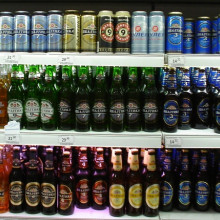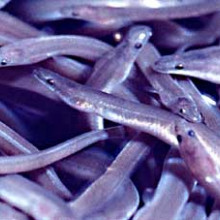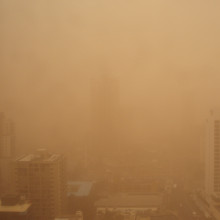This week, we find out how alcohol effects perception of risk vs reward in the adolescent brain and discover how scientists are studying the enormous migration of eels. Plus, Chris fills us in on his adventures in Australia, including waking up to an incredible dust storm...
In this episode

Alcohol and Risk in the Adolescent Brain
For a long time, we've known that people who abuse alcohol tend to be very bad at making decisions and particularly gambling-type decisions weighing up options: "Should I take the gamble and go for a big possible win or should I take a sure fire smaller win?" Research published in the Journal PNAS this week looks at the question of alcohol and alcohol abuse.
 The big question is, do people who are prone to drink too much also prone to make bad decisions? Or does the alcohol make them more prone to make bad decisions?
The big question is, do people who are prone to drink too much also prone to make bad decisions? Or does the alcohol make them more prone to make bad decisions?
A group of researchers at the University of Washington in Seattle, Nicholas Nasrallah and his colleagues, decided to set out to answer that question.
This study used rats because, obviously, it would be rather unethical to try and use the human teenagers they're interested in trying to understand. But they wanted to assess the effect of alcohol on the developing brain and rats are a very good model for how human brains make decisions. The only slight snag is that, unlike teenagers, you can't get teenage rats to want to drink too much so they found a way around the problem. They developed the rodent equivalent of vodka jelly which these rats will imbibe and this led to a sustained high intake of alcohol over a period of time in these rats.
After they have given these adolescent rats the alcohol-impregnated gel for a period of time they gave them a gambling task to do. So the rodents were made slightly hungry so they want to participate in the research, which involves giving them food rewards and they offer them a choice. The first choice is they can have a small outcome, two food pellets, but they'll definitely get it. Alternatively, they could have a high-risk gamble and they may get four food pellets. But the more times that they do the trial, the less and less likely they are to get those four food pellets.
Now if you do this with normal animals that have not been exposed to alcohol, they quite quickly cotton on to the fact that they might do quite well to start with, but later, it's much better to take the sure fire win situation because you're going to get something - you're not going to get left with nothing.
But these rats that have been exposed to alcohol, consistently, time after time, made the wrong decision. They couldn't learn that if they kept taking the gamble, it was going to have a bad outcome and they kept going for the high-risk outcome and in the end became croppers as a result. Now this isn't just because they weren't drinking alcohol at the time, this was in some cases up to three months after the exposure to the alcohol had stopped.
The researchers suggest that the alcohol is in some way affecting how the teenage brain is wiring itself up. Maybe it's triggering a condition called perseveration, which is where the brain struggles to size up the scale of the problem and then change its behaviour accordingly. It's almost like the brain gets locked into one path of action and finds it very difficult to add additional variables or parameters so that it changes its outcome. But it's very informative because it says to us, look - if we're not careful with young humans, if they take sustained exposure to alcohol as many are doing, then it could be that they are changing the way that their brain works. And they're going to be cruising for a cognitive bruising later because this will lead them to, maybe make those decisions when they're older.
It's important not to confuse this with a social drink of "watered down wine" with the family at dinner on a Sunday because that kind of alcohol exposure is almost certainly not going to have such an effect. The animals in the study where being exposed to what would equate to quite sustained heavy drinking: the kind that you see in nightclubs that you have to actually try quite hard to achieve.

The Mighty Eel Migration
There are two really interesting papers this week on migration; one of which looks at eels. Eels are a hot topic because, as well being the thing that you put in jellied eels and which many people find very, very tasty, eels are in decline. Their numbers have gone down enormously in recent years and they're actually an animal which we know very little about but they make huge migrations across the oceans. They go 5,000 kilometres from Europe, all the way across to the North Atlantic to a place called the Sargasso Sea, which is where they mate and reproduce. If we are to try and conserve this species, we need to understand how they do that, how they make this journey and what the parameters of that journey are. Because if we don't understand anything the species, how can we save them?
 Unfortunately there are problems with tracking a fish which swims about underwater, sometimes a thousand metres underwater.
Unfortunately there are problems with tracking a fish which swims about underwater, sometimes a thousand metres underwater.
A group of researchers at the Technical University of Denmark: Kim Aarenstrup and her colleagues have a paper in Science this week. They've built very small satellite transceivers which they can put onto the eels. They released 22 eels in the West Coast of Ireland and let them swim off in November 2006. Every time these eels surfaced, the satellite transceivers would upload data on where the eel was, its position, where it had been in the water column and details about water environment that it was experiencing on its way.
They then reconstructed some of the eels' journeys to a distance of about 1,300 kilometres: a quarter of the way towards the Sargasso Sea.
And now we have some of our first insights into how they do this. The really interesting part is that these eels, after they depart, travel about 25 kilometres a day. But the researchers say that's actually too slow to get where they need to go by April, which is when they need to go to Sargasso Sea to mate.
So what are they doing?
The researchers suggest that what they do is swim down to Africa and then hitch a ride on a fast-moving ocean current which helps them to speed up and get the rest of the way much more quickly.
But one of the really intriguing bits of data was that the eels change their height in the water column between day and night. So during the daytime, they swim much deeper. They go down to about a thousand metres and at night time, they come up close to the surface.
Now, lots of animals do this because they come up at night time to warmer water to feed. But eels don't eat anything on their way to Sargasso Sea.
So why are they doing it?
The researchers think the warmer water closer to the surface is bad news because it speeds up the eels' metabolism and it makes them mature faster - because they need to make sure they're reaching sexual maturity when they reach the Sargasso Sea to mate. So by swimming along most of the time at deeper water and therefore lower temperatures they're actually slowing down their development and this means that they're in a position to be just in the right place, at the right stage of development. So when they get to the Sargasso Sea, they can mate. So it's an intriguing bit of research.

Caught in a Dust Storm
For this week's news, we caught up with Chris Smith shortly after his return from Australia...
Chris - I was in Australia because I went there to give a talk in Brisbane which is at the conference and that which it's about halfway up the east coast of Australia. And then I flew down to Adelaide, which is down in the bottom in the middle of Australia, to give a talk there and to do some interviews for some people.  Then I went over to Sydney to see some friends of ours at the ABC, the Australian equivalent of the BBC. And I woke up on a Wednesday morning and I thought I've gone mad. Because when you first wake up, you're not sure if your brains are actually playing tricks on you? When I woke up in the room, it was orange. No. There's something funny about this and I went back to sleep. And I woke up again about 10 to 15 minutes later, and now the room really is orange and I thought the city was on fire. This funny colour that was coming into the room and I ran to the window and I looked out and I couldn't see the end of the street. The whole street was bright, orangey red and the cars were orange. It was like a very dense fog but bright red.
Then I went over to Sydney to see some friends of ours at the ABC, the Australian equivalent of the BBC. And I woke up on a Wednesday morning and I thought I've gone mad. Because when you first wake up, you're not sure if your brains are actually playing tricks on you? When I woke up in the room, it was orange. No. There's something funny about this and I went back to sleep. And I woke up again about 10 to 15 minutes later, and now the room really is orange and I thought the city was on fire. This funny colour that was coming into the room and I ran to the window and I looked out and I couldn't see the end of the street. The whole street was bright, orangey red and the cars were orange. It was like a very dense fog but bright red.
And it turns out that what was happening was a very big storm over central Australia and the south part of Queensland, the state higher up the coast of Australia above Sydney had whipped up enormous amounts of top soil. And the top soil in Australia is very rich in iron oxide - rust, and that's why it's very red. And in fact, when measurements were made, it turns that this storm was dumping 75,000 tons of dust...
Ben - Wow.
 Chris:: ...into the ocean every hour, that it was blowing this 600-mile long dust storm across Sydney. Sydney was right in the path of it. It did clear by lunchtime on Wednesday but I just heard from my friend Robin Williams who presents the Science show - the flagship Science Show in Australia and he said the dust is back today...
Chris:: ...into the ocean every hour, that it was blowing this 600-mile long dust storm across Sydney. Sydney was right in the path of it. It did clear by lunchtime on Wednesday but I just heard from my friend Robin Williams who presents the Science show - the flagship Science Show in Australia and he said the dust is back today...
Ben - Oh no!
Chris - ...and this time it's brown. Not very nice and it presumably comes from a slightly less ionic oxide, rich bit of Australia this time. But certainly wary, they've never seen anything like this for more than a hundred years.
Ben - The photos I've seen were very incredible. It must have been very surreal.
Chris - It was pretty weird when normally, the temperature there should be nice and high. It should be clear and sunny and to be driving to work in that. And it was very unpleasant because it got into other buildings and you'd be sitting trying to have a conversation with somebody and every time you took a breath in to sort of breathe to speak, you'd feel this sort of cloying heaviness in the back of your throat because it was so dry, and it was very unpleasant. Lots of people ended up going to hospital with respiratory problems being exacerbated by the dust. The one benefit though was it actually made riding in the lift, which was air-conditioned. A lot more pleasant because it was the one place where the air was actually okay.
Related Content
- Previous Brainy Birds
- Next Researchers Revealed!










Comments
Add a comment